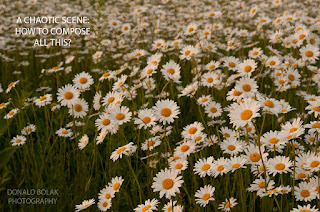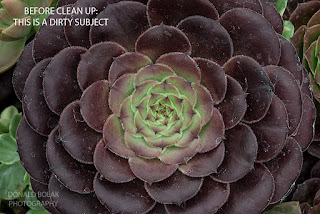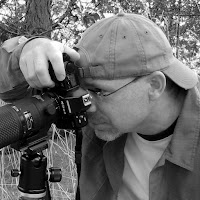In
my upcoming CAPS presentation ‘Better Composition – How to Work A Subject’ my
goal is to provide you with an overview of what I consider the essentials of the
process of photographic composition and include various tips/tricks
along the way. One of the key topics I
will review: Is Your Subject Photo
Worthy?
 So
what exactly am I talking about here?
Have you ever gone on a photo shoot and been overwhelmed with the number
of possibilities? You search and search
and finally find something to get excited about. You spend some time setting up, get your
perfect shot, and go home a happy photographer.
Until you look at your images on the computer monitor and it turns out
the shot was not that hot! And then the
regrets set in: What was I thinking!?
What a lost opportunity? I cannot
believe I thought that was great! Check
out these daisy images. Which image
would you rather see on your computer?
So
what exactly am I talking about here?
Have you ever gone on a photo shoot and been overwhelmed with the number
of possibilities? You search and search
and finally find something to get excited about. You spend some time setting up, get your
perfect shot, and go home a happy photographer.
Until you look at your images on the computer monitor and it turns out
the shot was not that hot! And then the
regrets set in: What was I thinking!?
What a lost opportunity? I cannot
believe I thought that was great! Check
out these daisy images. Which image
would you rather see on your computer?Being able to evaluate potential subjects in the field before you setup and start shooting is hugely beneficial and time saving. You do not always have the leisure of time to take a shot. Light is changing constantly during the golden hours for photography around sunrise and sunset. Your animal, bird or insect subject may not wait around for you. Even the wind may start to pick up and end your day for doing close up images of flowers.
 You
also need to be able to look at subjects and determine if the subject is really
that good. One of the greater challenges
you need to face: what you see is not
what you get in the camera. The tools
you are using to visualize your shot is a small view
finder or a low resolution LCD screen.
It’s easy to miss things. For
close up photography - trying to see
flaws and dirt on that flower in a dark view finder at f22 is difficult. I cannot tell you how much time I have to
spend cleaning up images. I literally do not see all that crap in my view
finder. For this Aeonium picture – I did
see that it was dirty and tried to clean it up in the field. Since it was a potentially a great photo, I
went ahead and shot it anyway. I had no
idea how dirty until I saw it on the computer monitor. It took me hours to clean this up in
photoshop. No fun there.
You
also need to be able to look at subjects and determine if the subject is really
that good. One of the greater challenges
you need to face: what you see is not
what you get in the camera. The tools
you are using to visualize your shot is a small view
finder or a low resolution LCD screen.
It’s easy to miss things. For
close up photography - trying to see
flaws and dirt on that flower in a dark view finder at f22 is difficult. I cannot tell you how much time I have to
spend cleaning up images. I literally do not see all that crap in my view
finder. For this Aeonium picture – I did
see that it was dirty and tried to clean it up in the field. Since it was a potentially a great photo, I
went ahead and shot it anyway. I had no
idea how dirty until I saw it on the computer monitor. It took me hours to clean this up in
photoshop. No fun there.
Another
way to think of it: I just attended the
Chicago Architectural Foundation’s Open House (if you are not familiar, check
it out on-line). I had 50 or so possible
buildings to visit over the course of two days.
No way I was going to come even close to seeing that many
buildings. How to decide what to
see? A casual conversation with another photographer
saved me from wasting time. “Do not go
to the XXX Building, the windows are filthy and you cannot get a good
shot”. If you were at that location,
would you spend substantial time taking photo’s or would you have noticed the
dirty windows and moved on to the next building? I picked another high rise buiding to go to
instead and got the following shot. My
thanks to that anonymous photographer.
Something else to consider: finding a worthy subject can take time. Wild life photographers know this well and cultivate great patience. It may take multiple excursions over the course of years to get that perfect mid-flight shot of that eagle. Let’s look at another example: for my flower photography, the sequence below took me about 3 months to get. I thought the flowers had great potential but the plants do not produce a lot of flowers over the course of the summer. So I had to wait for them to flower; wait for good conditions (lighting, wind, etc.); and finally wait for the perfect flower. As you can see in the sequence below, I also had to learn from my mistakes - bad background, bad light, bad composition and bad subject (the 4 bads – now that’s BAD). I improved over time until I finally had success.
Hopefully you are starting to get the idea. You have to be able to decide what is interesting to you; edit the scene; evaluate the subject quality; AND THEN apply all your photographic tricks/techniques to get the great shot. Hope to see you Sunday November 22nd at my CAPS presentation.
 A serious
hobbyist for over 15 years, Don has received numerous awards for his
photography, exhibited widely and has been published in newspapers and
magazines (most recently Natures Best Magazine). While he pursues many different types of
photography (abstract, landscape, garden, architecture, wildlife), his primary
interest is botanical and close-up/macro photography.
A serious
hobbyist for over 15 years, Don has received numerous awards for his
photography, exhibited widely and has been published in newspapers and
magazines (most recently Natures Best Magazine). While he pursues many different types of
photography (abstract, landscape, garden, architecture, wildlife), his primary
interest is botanical and close-up/macro photography.
He tries to
portray the incredible diversity of color, form and subject matter found in the
"micro world."
With a day job as a landscape architect, Don’s
professional training in design and botany along with his expertise in
photography makes him a popular speaker.
He has presented at past Chicago Area Photographic Schools, Lake County
Expo, Out of Chicago Conference and other venues.
Website: Donald Bolak Photography
Website: Donald Bolak Photography
To
go to the CAPS website go to:
To
register for CAPS go to:








No comments:
Post a Comment